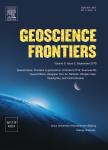Re-folded structure of syn-orogenic granitoids(Padrón dome, NW Iberia):Assessing rheological evolution of cooling continental crust in a collisional setting
Re-folded structure of syn-orogenic granitoids(Padrón dome, NW Iberia):Assessing rheological evolution of cooling continental crust in a collisional setting作者机构:Departamento de GeodinámicaEstratigrafía y PaleontologíaFacultad de Ciencias GeológicasUniversidad Complutense de Madrid Instituto Geológico y Minero de Espana
出 版 物:《Geoscience Frontiers》 (地学前缘(英文版))
年 卷 期:2019年第10卷第2期
页 面:651-669页
核心收录:
学科分类:0709[理学-地质学] 07[理学] 070901[理学-矿物学、岩石学、矿床学] 0708[理学-地球物理学] 0704[理学-天文学]
基 金:Financial support has been provided by Instituto Geológico y Minero de Espana(Project IGME 2281) by Ministerio de Economía,Industria y Competitividad of Spain(Project No.CGL2016-76438-P) contribution to IGCP project 648(Supercontinent Cycle and Global Geodynamics)
主 题:Recumbent folds Migmatitic domes Partial melting Crustal-derived granitoids Orogenic collapse Variscan orogen
摘 要:This contribution discusses about the rheological, kinematic and dynamic frameworks necessary to produce recumbent and upright folds from syn-orogenic granitic massifs that were formed during an early stage of magma genesis related to the onset of a migmatitic dome. Syn-kinematic granitoids occurring within the high-grade infrastructure of the Padron migmatitic dome(NW Iberia) are deformed into largescale recumbent folds(D_2) that are later affected by upright folds(D_3). Petrostructural analysis of a selected area of this dome reveals that after a period of crustal thickening(D_1), NNW-directed extensional flow gave way to recumbent folds and penetrative axial plane foliation(S_2). Superimposed subhorizontal compression resulted in upright folds(D_3). A closer view into the dynamics of the dome allows exploring the factors that may condition the nucleation of folds with contrasting geometries during progressive deformation of molten continental crust. The formation of folds affecting syn-kinematic granitoids suggests a cooling metamorphic path in migmatitic domes. Active and passive folding mechanisms require a crystallizing(cooling) magma to nucleate folds. A more competent metamorphic host inhibits fold nucleation from much less competent magmas. As it crystallizes, magma becomes more rigid(competent),and approaches viscosity values of its host. Passive folding is favored when no significant competence contrast exists between magma and host, so this folding mechanism is more likely shortly after magma genesis and emplacement. In such conditions, and under dominant subhorizontal flow accompanied by flattening(D_2),passive folding would produce isoclinal recumbent geometries. Further magma cooling introduces a shift into the rheological behavior of partially molten crust. Thereon, crystallizing magma bodies would represent significant competence contrasts relative to their host. At this point, buckling is a more likely folding mechanism, and more regular, buckle folds re-fold previous structures after significant cooling. The geometry of resulting folds is upright due to dominant subhorizontal compression(D_3) at this stage.



